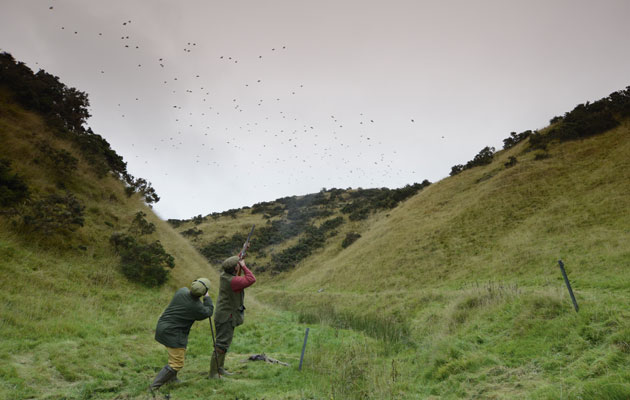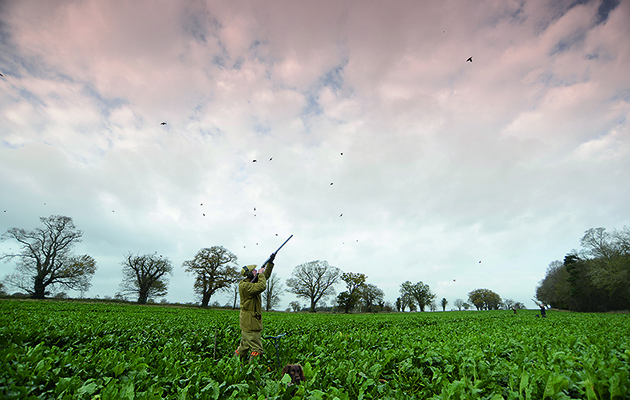Edward Watson: My favourite part of the UK in which to shoot redleg partridges is the area off the A303…
Win CENS ProFlex DX5 earplugs worth £1,149 – enter here
Getting up to speed on partridges
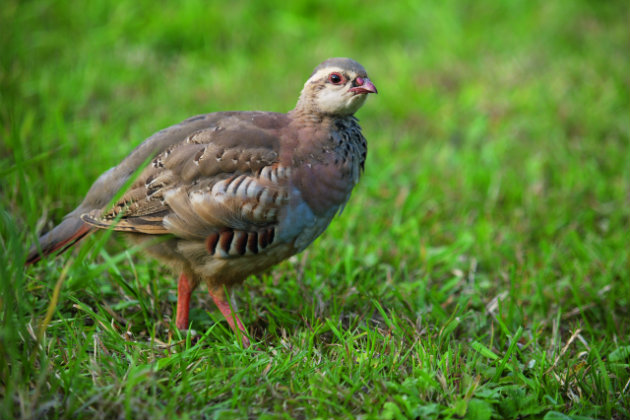
There is something very English about shooting partridges over stubbles in autumn. Once, the majority of driven shooting in England was partridges; not the French red-legged variety but our own beautiful English, or grey, partridge. Modern agriculture in the 1980s sadly had a huge effect on the stronghold of the grey, but there are committed landowners and farmers out there doing their utmost to see this amazing bird flourish once again.
Traditional driven partridges were presented over tall, thick hedgerows and belts of trees, with excited Guns waiting on the other side. However, these days you are more likely to see partridges added as an exciting extra to a shoot day. Many small farm shoots and syndicates will put down a few partridges to add to the variety of a day’s sport, and I don’t know many Guns who wouldn’t take great pleasure from being one of those who adds a partridge or two to the final bag on a day that is predominately pheasant.
French partridges over hedgerows, tree belts and small valleys or even gamecover on at ground are exciting and each bring their own challenges.
So, where do you start if you want to improve your consistency with partridges? In this article I will focus on French partridge as, at present, 99 per cent of Guns will be shooting these rather than the English version. The following tips should help you make the most of your chances.
Shooting traditionally presented partridges brings its own risks
Safety is always your first priority as a Gun. Shooting traditionally presented partridges brings its own risks and different situations to look out for. Once on your peg, make yourself aware of where your neighbours are, and if you draw a peg where you have a dividing hedge, make sure you know where the Gun is located on the opposite side. I was nearly shot by a Gun years ago because he didn’t realise where I was on the other side, so I now make sure my neighbour knows where I am.
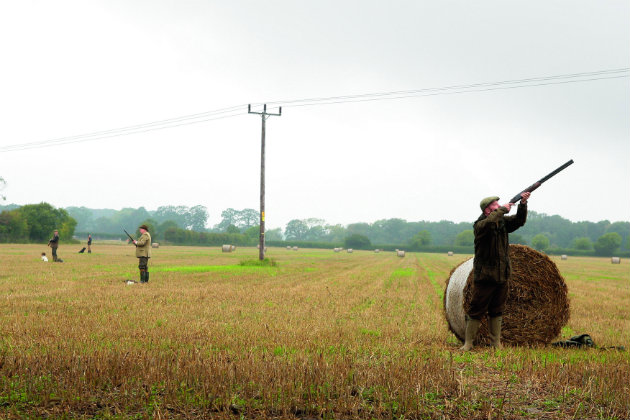
Once on your peg, make sure you know where your neighbours are (above). Find out where the pickers-up are located – it is courteous to acknowledge them
Pickers-up will be way back, but with lowland shooting you may not have a clear sight because hedgerows or belts of trees could mask where they are standing. If this is the case, check with your host or keeper so that you know their location. If you can see where they are, acknowledge them. It is courteous to let them know that you know they are there.
You can shoot birds going back but make sure there is sky behind the bird if you choose to do so. Partridges, especially early-season ones, can lose height quickly once over the line, so under no circumstances should you take a low shot. Coveys can suddenly appear and, unlike shooting partridges in valleys or from gamecover on flat ground, you may have a fairly short window from you to the hedge or belt of trees. Be aware of your angles of fire and stay alert.
The bird and the drive
With any gameshooting, the more you understand a bird’s behaviour the better you will shoot. Partridges can be deceptive in flight because they give the impression of moving at considerable speed. French partridges are not big birds and will fly at speeds of around 30mph to 35mph. This is slower than a pheasant, but it is the size of the bird that makes it seem as though they are flying faster. Big coveys also add to this deceptive speed and this is why many Guns panic. French partridges have a fairly quick wing-beat and, on approaching a line of Guns, can suddenly pull up. Be prepared for this.
On approach, they may present what is an unsafe shot, but suddenly pull up to present a shot. If you watch carefully, you will see a bird suddenly accelerate and gain height. Birds approaching the line that have a lesser wingbeat and then lock their wings will not pull up but will simply glide past the line — in many cases too low for a safe shot. Generally, partridges will climb, rising gently, over a line of Guns.
It is important that you read the drive because it will help you work out how the approaching birds will take on the line.
Wind conditions always play a big role — wind will affect the speed and direction of birds and coveys in flight — but don’t ever think that because you are on the wrong side of the wind you will be out of the shooting. It amazes me how partridges will cut back into a strong wind. Fieldcraft and understanding the bird really can help your shooting.
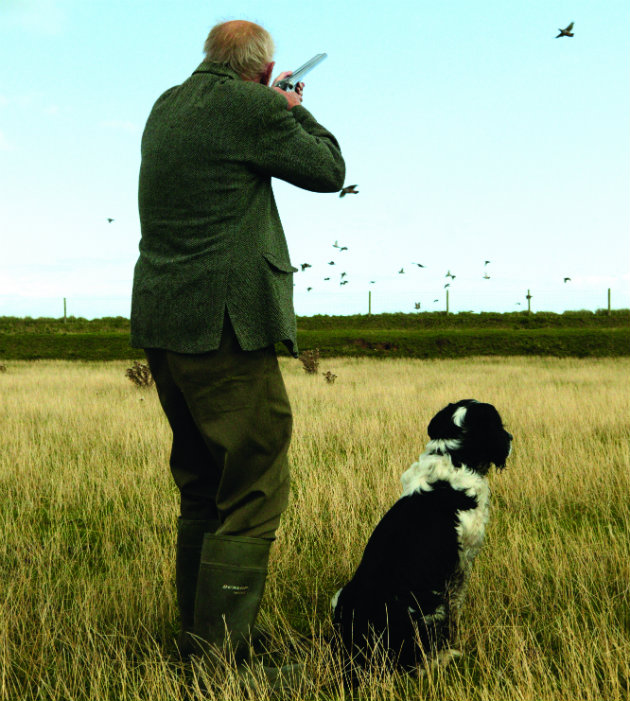
There is something very English about shooting partridges over stubbles in early autumn
Bird selection and technique
For most Guns, being able to select a bird from a covey calmly and confidently is the biggest challenge. A lone partridge going over the line inevitably gets shot, but it is amazing how whole coveys can run the gauntlet and come out the other side unscathed.
Tom’s top tips on shooting partridge and bird selection
- Focus and concentration during the drive is vital. If you don’t stay alert, you will get caught out. Don’t worry about who’s shooting what; focus on your peg and your zone. So many Guns get caught “ball-watching” only for a covey to come over the line. What follows is poor bird selection, if any, complete panic, bad timing, a rushed shot and then an inevitable miss. Next comes frustration and a knock in confidence.
- When coveys start taking on the line of Guns, look through the covey, not at the whole covey. If you focus on a point in the covey, you will naturally be drawn to your first bird. Once you have selected your bird, do not change your mind unless the shot is suddenly unsafe. If safe to do so, shoot the first bird as early as you feel comfortable. This will then allow you to move to your second bird. Don’t think right-and-left; concentrate on shooting the first bird cleanly and then you can worry about the second.
- Make sure you address the covey and your selected bird correctly. Hold your muzzles relative to the height of the bird, just below its line. This, in turn, will enable you to mount your gun smoothly on to your chosen bird. Always keep your head still and focus on the selected bird — focus and a solid connection to the bird are what give you smooth timing. Do not hesitate — believe in what you see. The fear of missing is a terrible thing, so shoot with confidence. Make sure you watch the bird fold so that you finish your shot properly.
- Footwork is the building block to any shot, but with traditional partridges don’t start dancing around. Too much movement will make too much of the shot and cause all sorts of problems, resulting in missing the line of a bird and poor connection to it. Move your feet before you make the shot so that there is no moving and mounting.
- Practice is essential, as with any sport, but make sure you practise under realistic clays that represent speed and angles. You should choose a shooting ground that offers coveys so that you can develop bird selection. Gaining tips from an experienced game Shot and instructor is always valuable.
Cartridge choice
I am always asked about my choice of cartridge. Like all shooters, I try to make sure that I kill my birds in the right place at the right distances with clean kills, as it goes without saying that this is very important. I tend to shoot all my pigeon and game with the same 32g No.5 load, regardless of what time of year it is. This is a personal choice and I have never felt over-gunned nor under-gunned.
Recommended choice for a 12-bore:
Side-by-side
28g, No.5, 6, 7
30g, No.5, 6, 7
Over-and-under
32g, No.5, 6, 7
30g, No.5, 6, 7
28g, No.5, 6, 7
Just a couple more things to be aware of when shooting partridges
- Walk to your pegs quietly. Partridges are nervous birds, especially later in the season. If they hear noise they will not hang around.
- Do not start shooting at pigeon before partridges have started to fly the line, and look out for the young hen pheasant through September. They are often mistaken for partridges in the early season, and mainly on the higher partridge shoots, but it is not uncommon for one to be misidentified in the heat of the moment.
Top 10 partridge shoots
Whether they are presenting classic East Anglian hedge skimmers, high birds in the chalk downs of southern England or sky…
Related Articles
Get the latest news delivered direct to your door
Subscribe to Shooting Times & Country
Discover the ultimate companion for field sports enthusiasts with Shooting Times & Country Magazine, the UK’s leading weekly publication that has been at the forefront of shooting culture since 1882. Subscribers gain access to expert tips, comprehensive gear reviews, seasonal advice and a vibrant community of like-minded shooters.
Save on shop price when you subscribe with weekly issues featuring in-depth articles on gundog training, exclusive member offers and access to the digital back issue library. A Shooting Times & Country subscription is more than a magazine, don’t just read about the countryside; immerse yourself in its most authoritative and engaging publication.






